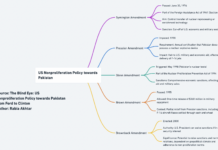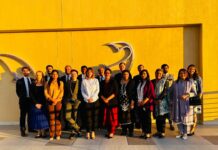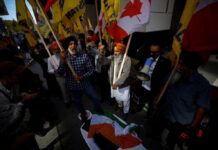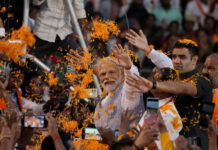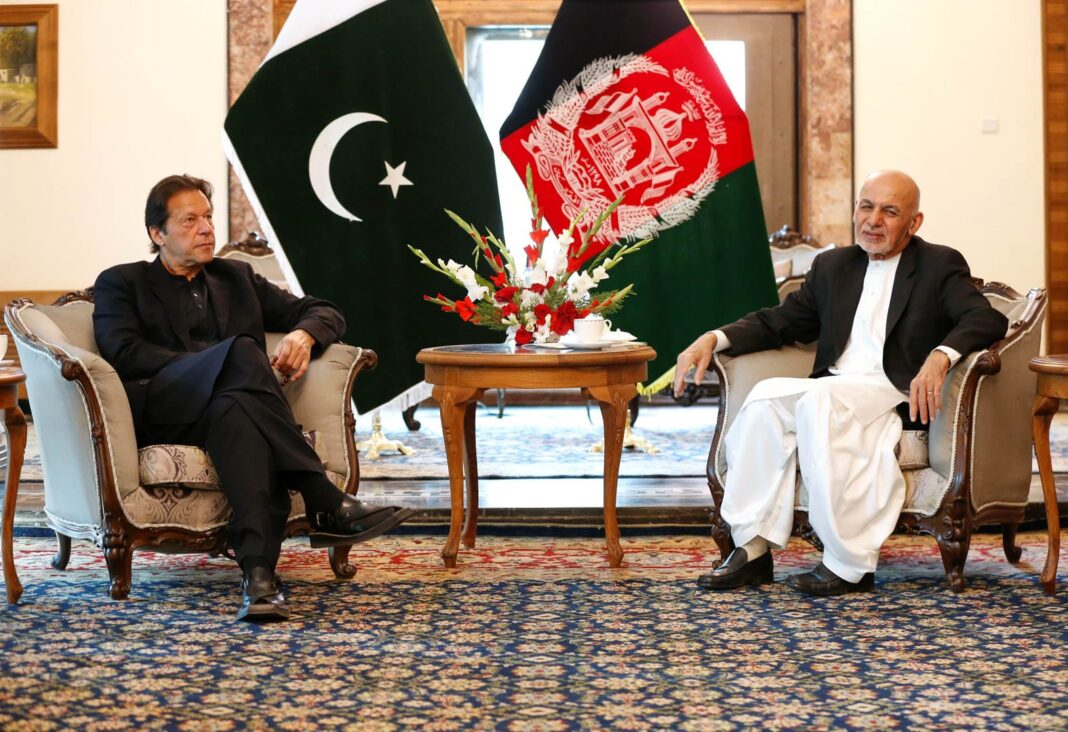Sabtain Ahmed Dar
After spending around $1 trillion in Afghanistan, the United States is leaving that country without achieving the political and security objectives associated with Operation Enduring Freedom (2001-2014). By virtue of being a partner of the United States, Pakistan has also endured a tragic loss of life amidst raging violence and extremism across the country. Since 2001, Pakistan has sacrificed 83,000 lives in the US-led war on terror. It has endured one of the most troublesome Internally Displaced Persons’ (IDP) crises in modern history. Nearly 3 million civilians from Swat and erstwhile FATA were displaced from their homes due to counterterrorism operations launched by the Pakistan Army.
If we talk in terms of the economy, from 2000 to2006, Pakistan had a stable economy with an average growth rate of 6.18%. However, after 2007, with the Red Mosque incident taking place, the country witnessed a rapid increase in suicide bombings and religious extremism which not only tarnished its reputation but also adversely affected the economic sector. While Pakistan had enjoyed debt write-offs, easy loans, foreign and military aid owing to its assistance in the U.S. war on terror, the costs of the Afghan conflict were far more than the benefits. Pakistan’s government has recently highlighted that the cost of war had reached US$126 billion in two decades. This cost includes the destruction to military, security, socio-economic, and developmental infrastructure related to agriculture and industry of Pakistan while fighting this war.
What we have achieved through this futile war and where we are headed as a nation, are two pertinent questions that agitate our minds even two decades down the road. The answers are not simple. There are a few things to consider while assessing this matrix. Firstly, in an attempt to find clarity about the reality in Afghanistan we need to establish a framework where we first identify political, economic, and security realities of the region that are unavoidable for Pakistan by virtue of its being a neighbor of Afghanistan. Secondly, by establishing these realities, we need to find rules of engagements through which we would first protect our national interests and then support economic integration of the region, to raise the cost of war and reduce the prospect of future military conflicts. The question that pundits and policymakers need to grapple with is this: how can Pakistan help Afghanistan and other stakeholders find order in a highly-chaotic environment?
Pakistan’s “Binoculars” on the Afghanistan Crisis
In spite of an elected government under President Ashraf Ghani the reality of who is under control of Afghan national affairs is quite different. In 2018, the evidence to the contrary came to the fore when the U.S. finally engaged with the Afghan Taliban in Doha for peace talks and the Afghan government was not even part of it. Moreover, the actual sovereignty of the Afghan government is contested beyond Kabul and its adjacent territories. On the other hand, despite not being elected or part of the Afghan government, the Afghan Taliban exercise authority over 85% of Afghanistan’s territory.
This use of power and authority over such a large land provided the opportunity to the Taliban to negotiate and diplomatically engage with the U.S. It is important to note that this power of the Taliban still remains independent of any electoral, constitutional status and also of all the clauses of Bonn Agreement which crafted the post-2001 dispensation in Afghanistan. Today, with over half of Afghanistan’s territory either under the control of Taliban or contested between the group and the Afghan National Army (ANA), the very sovereignty and authority of Afghan government is severely marginalized. However, the current Afghanistan government under Ashraf Ghani remains a significant part of Afghanistan’s political scaffold, and thus has a role to play in shaping its future course and outlook.
Afghanistan’s ethnic and political fault lines have played a great role in preventing the country from devising a coherent policy that could have achieved the status of ad susceptum perficiendum. On the one end, the Afghan government is accused of being a U.S. appendage, and, on the other, the Taliban are accused of being radicals and extremists who are conceived as a great obstacle in the development of Afghanistan under Ashraf Ghani’s government. However, currently the traditional view on Taliban has gone into a transformation, as they have been given a greater role by the international community to put forth a strategic plan for Afghanistan. After the US-Taliban agreement, there is still a chance for all stakeholders inside Afghanistan to continue, despite many hiccups, intra-Afghan peace talks to formulate such a cohesive policy that crafts not only peace among all parties but also the course of Afghanistan’s future. That said, the window is fast-shrinking owing to Washington’s precipitous withdrawal from Afghanistan and Taliban’s military gains.
Thus, for Pakistan, only a political settlement in Afghanistan is desirable, especially given the fact that it cannot afford a civil war to rage in that country. In order to achieve this, Pakistan’s policymakers cannot neglect the internal dynamics of the Taliban. Assessing the changing dynamics inside the Taliban will greatly help Pakistan formulate any rule of engagements with both the Afghan government and Taliban themselves. But it is important to note that without understanding what is causing this change, the outcome of any engagement cannot be measured. The Taliban of today can be classified into an entity that mainly comprises two major units;
a- The political leadership of Taliban
b- The military leadership of Taliban
Therefore, the relation between these two determines the strength and validity of Taliban as a whole and their sovereignty inside Afghanistan. At one end, Taliban’s political leadership seeks control of Afghanistan through politics (i.e., Doha Talks, Intra-Afghan talks) on the other end,Taliban’s military leadership seeks control of Afghanistan by use of force , as we have recently witnessed Taliban taking control of 170 districts in just six weeks. While it shows a joint realpolitik strategy of Taliban’s politico-military establishment, it is also likely that the recent surge by the military leadership of Taliban may show a discontent against the political leadership of the Taliban. Pakistan cannot remain oblivious to the changing dynamics within the ranks of the Taliban. Pakistan should complete its fencing all throughout the border with Afghanistan to minimize all ensuing effects of Taliban’s surge.
Amidst Taliban’s surge and hullabaloo of a civil war, there are views that a power-sharing formula may not work between the Afghan government, the Taliban, and other groups from central and northern Afghanistan. Realistically, this view does not appear to hold much weight, but Pakistan, for its part , can suggest Taliban not to punch above their weight and remain committed to pushing ahead the Afghan peace process. However, there are two reasons as to why this might be a tall order. One, in spite of its entire military prowess and technological advancement, the U.S. was forced to engage in peace talks with the Taliban, whose lion’s share in the government is just around the corner. Two, the Taliban control large part of Afghanistan without being elected constitutionally. With them being in such a preponderant position, it is less likely that their behavior could be altered by Pakistan, or any other country, for that matter. At best, Pakistan should try to convince the Taliban that they have much to gain from a peaceful, workable, and acceptable political settlement in Afghanistan.
Navigating the very many challenges in Afghanistan is going to be fraught with risks should stakeholders decide to ignore that country’s demographic realities The Pashtuns have always been in a majority, who ruled and governed Afghanistan in one way or the other. The Taliban are primarily Pashtuns who seek a Pashtun-dominated government in Afghanistan. Historically and demographically, this view on the part of the Taliban holds weight and it is the correct version of the Afghan movement of history. Any poorly-organized effort to neglect this historical reality can only have deleterious effects on the region. It is now a common knowledge in the international community that the Taliban are a force to reckon with inside Afghanistan. In both war and peace inside Afghanistan, it is evident that the Taliban are accepted as part of Afghanistan’s future. Any attempts on the part of Kabul regime to diminish Taliban may end up into a prolonged chaos and anarchy inside Afghanistan. Therefore, Pakistan will have to engage all parties with a view to playing its part in keeping the peace process intact.
This leads us to the question of whether Afghanistan will be a “Republic” or an “Emirate”. The calculus of power amidst changing dynamics inside Afghanistan is witnessing a transformation. As the Taliban seem to be dominant inside Afghanistan, their demand for an Islamic Emirate of Afghanistan (IEA) would put Bonn Agreement (2001) and the new US roadmap for Afghanistan in complete jeopardy. Therefore, the political and socio-economic structures of modern Afghanistan are likely to witness a great change. However, a mutually-inclusive vision of both Kabul and Taliban can establish a common ground between the two. Despite the fact that “Islamic Emirate” is in opposition to the modern western civilization that runs itself on the principles of secular humanism, it must not neglect the fact the latter drives the political, economic, and financial apparatus of the world order.
If Taliban is to establish an “Islamic Emirate” they must ensure first whether they want to integrate themselves into the international system or become a breakaway civilization such as that of North Korea. The current debate regarding an “Islamic Republic” versus an “Islamic Emirate” in Afghanistan is the result of the very war against these two rival systems of governance; where at one end we have western liberal democracy and, on the other, we have an Islamic system of governance. It would be an ideal scenario for both Kabul and Taliban to engage in a hybrid system of governance, a system in which the politicos of Kabul can continue with their traditional apparatus with ease and Taliban can exercise their principles of Islamic governance. This hybrid system of governance would be ab initio reconciliationis within itself, a rapprochement through which a new constitution of Afghanistan can be drafted, to include all the stakes of all the parties inside Afghanistan. This would also ensure the democratic values of the West, which are crucially important for the recognition of Islamic Emirate of Afghanistan in the international system.
As of now, it is becoming apparent that Taliban’s surge across Afghanistan is the result of the mistrust between Ashraf Ghani, Abdullah Abdullah, and the Taliban themselves. Therefore, It is of utmost importance for the Kabul government to deal with the reality that is the Taliban phenomenon and give them a share in the government. The modus operandi for which we seek a modus vivendi inside Afghanistan is only possible through the acceptance of the Taliban by the Kabul government. However, it will most likely require time, continuous effort and honesty among all the parties. On the other hand, Pakistan’s binoculars do not need large lenses, for being Afghanistan’s neighbor it has suffered the most and it must always remain concerned with what happens inside Afghanistan. It is now an established fact that the road to peace in Pakistan goes through Afghanistan. It is in Pakistan’s interests to remain neutral while trying its best to push warring parties towards a political settlement. This becomes all the more important at a time when it wants to anchor its foreign policy within the broader concept of geoeconomics.
Sabtain Ahmed Dar is a Lecturer in the School of Integrated Social Sciences, University of Lahore.



